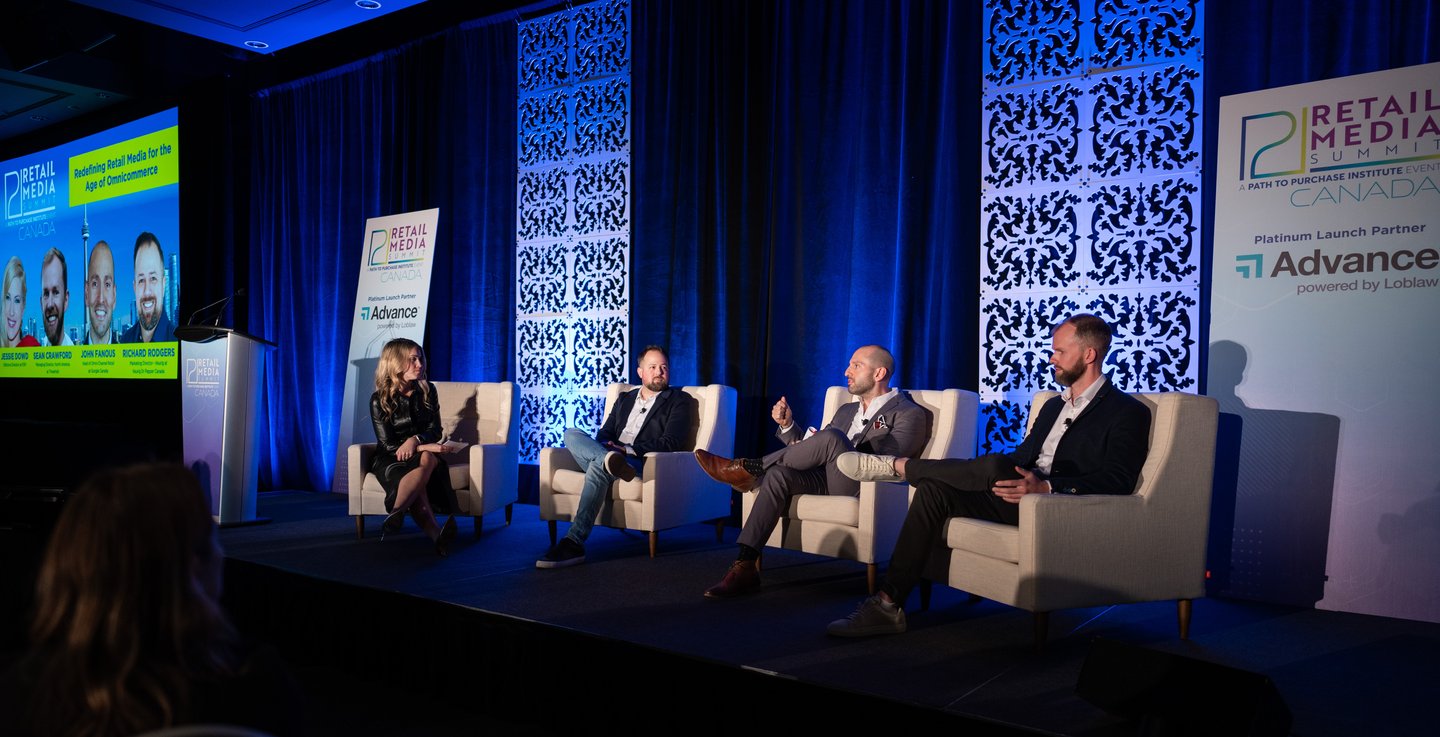Retail Media Summit Canada Recap
The Path to Purchase Institute brought its popular Retail Media Summit to Canada in February. Retailers, brand marketers and solutions providers alike gathered on Feb. 6 at the Toronto Congress Centre to unpack the retail media challenges and opportunities unique to Canada as well as across the globe. Topics and themes from P2PI's inaugural Retail Media Summit Canada ranged from the importance of closed-loop measurement and an omnichannel approach, to organizational mapping and enhancing a shopper’s experience across the path to purchase.
Read on for a few key highlights from the day:
The Media Revolution: What's Next for Canadian Marketers?
The numbers surrounding retail media's growing influence and power in the marketing industry are usually huge across the globe, and it's no different in Canada. Retail media ad spend is expected to reach 5 billion Canadian dollars by 2027 (a huge jump from 2 billion Canadian dollars in 2022) and, in less than three years, will double the ad spend of traditional TV.
While it continues to grow in importance, retail media has also become commonplace in the commerce marketing industry. "This is no longer an emerging media format. [Retail media] is here," said Jeremy Vianna, vice president and general manager, audience and ad products, Advance powered by Loblaw, noting retail media will account for 1 in 5 digital ad dollars spent in Canada this year. "It's not in the startup phase anymore. It's a trusted part of a marketer's playbook."
In his session kicking off the event, Vianna urged attendees to consider a few key practices and trends to inform and advance their retail media strategies and campaigns. Among them, Vianna suggested taking into consideration both the e-commerce shopper journey (opening email, browsing deals in a digital circular, checking out online, etc.) as well as the in-store purchase journey (hear or see an in-store ad, etc.). Analyzing campaigns run though the retailer, Vianna said advertisers that are layering tactics across different modalities (onsite and offsite) are seeing major lift in their conversion success (versus those activating offsite media alone).
"People move in and out of different buying behaviors," Vianna said. "When you think about the myriad and drastic increase in marketing touch points that you have available, you have to have a plan to be able to address all these things. The idea is not to think about the physical journey or the digital journey as an 'or' but to think of them as an 'and.'"
Another trend Vianna highlighted was the adoption of connected TV and streaming platforms among consumers, and connected TV ad spend in the country projected to reach nearly 1 billion Canadian dollars by 2025. Responding to this shift as well as the deprecation of third-party cookies, retail media networks are partnering with streaming and connected TV platforms to align with consumer habits embracing streaming and smart TVs and offer better, measurable solutions to advertisers.
Lastly, Vianna spoke about three key measurement requirements to unlock the opportunity of the next wave of retail media:
- Credible: Creating trust between retail media networks and advertisers. We don't want RMNs grading their own homework, like platforms have done in the past, explained Vianna. Third-party verified data is foundational to building trust.
- Scalable: Lack of measurement standardization hurts scale. "If we can't compare one retail media network to another, in a way that's trusted, then how do you as an advertiser ration or figure out how to plan? How to buy," Vianna said, noting simple metric definitions and consistency across networks will allow marketers to speak the same language.
- Actionable: Moving from purchase attribution to telling the story of incremental sales. "We started with 'you saw an ad and you made a purchase,' ... but we clearly need to go further,” he said. “We need to get to causal data, to actionable insights to really understand what's happening."
Navigating Growth: A Strategic Approach to Measurement and Audience in the $129 Billion Retail Media Landscape
Retail media is akin to a very high-level sport, said Claire Wyatt, reflecting on her career with retail media network Roundel and now with Albertsons Media Collective as vice president of business strategy and marketing science.
"It feels like you have to show up every day and be very aggressive [and] you kind of fall a lot," Wyatt said.
Examining retail media's emergence and evolution over the years, the first wave of retail media in the U.S. began with a focus on monetizing a retailer's own digital properties (solutions like onsite search and display) and driving gross margin. "Retail media 2.0" was a pivot to retailers operating more like a media publisher.
"Retail media 3.0 is a complete integration of the entire business that perpetuates the flywheel of retail media," Wyatt said. "It is ... [about] how do you gather as much data about your customers, in a very privacy-focused way, as quickly as possible, and then use that data to then monetize what we now call retail media — but my expectation is, in the future, it'll be something different and something even more data-centric."
Expanding on this, Wyatt highlights how retail media is not just a media channel (with solutions on retailer-owned properties), but also a layer that supports other channels. First-party data from RMNs can be leveraged for targeting and attribution on digital ad channels such as Roku, Facebook and Google.
"When we talk about spend shifting into retail media, it is somewhat shifting to retail media from other channels, but it is actually really a different way to activate those channels," Wyatt explained.
The value proposition of a retail media network is closed-loop measurement and audience data, Wyatt said. When it comes to measurement, there are three key considerations for Albertsons:
- Closed-Loop Measurement: The importance of being able to tie the advertising (inclusive of online and in-store) to a sale. (If this is an issue, Wyatt advised leveraging third-party partners for help.)
- Incrementality: Incremental return on ad spend (ROAS) showcases the true impact of media. There are various methodologies to incrementality measurement but, the most important is not which is employed, but rather an RMN's transparency with its clients, Wyatt said.
- Key performance indicators (KPIs) tied to objective: As retail media moves up the funnel, it’s important to add more KPI’s than just ROAS. KPI’s like "new customer" or "customer lifetime value" will become more popular as retail media networks expand into more awareness channels.
When considering campaign objectives, such as awareness and sales, there are related and appropriate strategies, channels and KPIs. A campaign with an upper-funnel, awareness objective, for example, should not have ROAS as a KPI, but instead a KPI such as “new to brand,” Wyatt said.
"One of the most important things to do when you are running media for your clients is to align in the beginning of the campaign on what is actually the objective and, therefore, what should the KPIs be," Wyatt said.
The Store as Media - The Shopper as Audience
When it comes to in-store retail media, the shopper experience needs to be top priority, according to Chris Riegel, chief executive officer of Stratacache, a global in-store retail media, digital signage and advanced sensor solution provider.
"We walk into retailers around the globe all the time [asking,] what are you trying to accomplish? 'I want more money.' Cool. Wrong, but cool. How are you going to improve that customer's journey ... should be the question," Riegel said. "Improve her experience in-store. Help her achieve that strategic goal and give her a reason to come back to your store more frequently to have a better experience."
Riegel highlighted a few solutions and examples to engage with shoppers in-store, including entryway kiosks displaying a touch-enabled circular and custom promotional content, and digital, interactive fixtures that offer product comparison, selection, and education similar to an e-commerce site.
He also shared a retail media three-point plan for retailers to consider. First, they should decide on whether they want to build a shopper marketing or digital out of home network. There are categories where DOOH makes sense (billboards, etc.) but, if they want to build a shopper marketing network they need to own that customer journey, Riegel said.
"I ask retailers all the time, ‘Who is your competition when you're selling a shopper marketing network?’ It's not Loblaws competing with Sobeys or Kroger competing with Walmart competing with Target. You're competing with TikTok, you're competing with Meta, you're competing with Google," Riegel said. "The difference is you have the shopper in your store and you have the product on your shelf and the ability to convert that sale. They do not."
Additionally, Riegel emphasized having digital screens in-store is simply not enough and a measurement infrastructure needs to be in place from the start. He also encouraged executives to start having dialogues with their loyalty and shopper insights teams to implement a streaming/CTV strategy.
Wrapping up his takeaways for the audience, he highlighted:
- Embrace customers as audiences in store and at home;
- The use of in-store media networks onsite and CTV offsite can open new paths to high-margin revenue that can significantly impact a company’s bottom line; and
- All uses of media should enhance a shopper’s experience and yield a more successful journey.
Sizing the Canadian Retail Media Landscape
There's no question that retail media has become the media darling. Sharing results from a "Canada Retail Media 2024" study eMarketer produced in conjunction with the IAB Canada, Sonia Carreno, IAB Canada president, highlighted a few insights that painted a picture of the current Canadian retail media landscape:
- Search will account for 65% of retail media ad spend this year. ("That's no surprise," Carreno said. "We're very comfortable with the fact that retail media plays a lower-funnel role in most of our media spending and it feels like the sure thing. It feels like it's contextually relevant. It feels like it's going to have a high ROAS and I think that that's a very Canadian approach.")
- 35% of retail media ad spend will be directed to display and video in 2024.
As part of the study, the top media buyers in Canada were also asked what the most important attributes are when buying ads in retail media. "Traffic quality" was cited as the most important attribute, Carreno said. "I suspect that Canadians are looking at this from a lower formal opportunity lens," she added.
Among some of the opportunities and challenges to work through within the Canadian market:
- Conservative attachment to lower-funnel performance advertising;
- First-party data jitters with new regulations in Quebec requiring consents and more rules to come; and
- Tech stack limitations (self-serve platforms are coming, Carreno said, but not at the speed and scale of the U.S.).
Redefining Retail Media for the Age of Omnicommerce
From organization mapping to emerging trends and strategies in the space, executives from Threefold, Keurig Dr Pepper and Google Canada shared their insights and positions on a variety of topics for a panel discussion examining the current retail media landscape in the U.S., Canada and across the globe.
Considering retail media's definition, Richard Rodgers, Keurig Dr Pepper Canada's marketing director – Keurig, said he approaches it as an enabler for a seamless omnichannel experience, allowing for personalized consumer experiences when they’re in the shopping mindset. Building on Rodgers' comments, Sean Crawford, managing director, North America, Threefold, emphasized the shopper is (or at least should be) at the heart of retail media.
"Retail media is not ad sales," Crawford said. "I think if we put shoppers at the heart of everything that we're doing, that's the true definition of retail media. And it's important that any marketing we do helps, absolutely, enhance their experience — whether that is in store or on [a retailer's] website."
As far as organizational mapping, Rodgers shared omnichannel efforts were being pushed internally at his company even before the COVID-19 pandemic, which only accelerated and forced the issue. Traditional shopper marketing and digital shelf teams merged and, most recently, the brand marketing team was brought into the mix (keeping the function separate but under one leadership).
"I think there's a lot of organizations that are interested in doing that or exploring that," Rodgers said. "We're lucky enough to [have taken] that plunge and it's been very successful for us and we anticipate other companies will follow."
Emphasizing the importance of brand presences and engaging shoppers across the path to purchase, John Fanous, head of omnichannel retail, Google Canada, shared that during the course of the 40-minute panel there will be 7,300 searches for shampoo and 3,000 videos viewed on YouTube on how to get lustrous hair. Moreover, he also shared that a third of Canadian consumers are actively seeking out an alternate brand to the one that they are used to buying.
"That means a lot of opportunities. Also, means a lot of risk," Fanous said. "Retail media's ability to actually leverage the knowledge of the customer to essentially bring the right message to the right customer has never been more important.”










